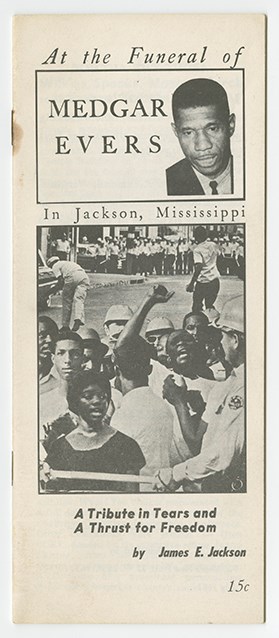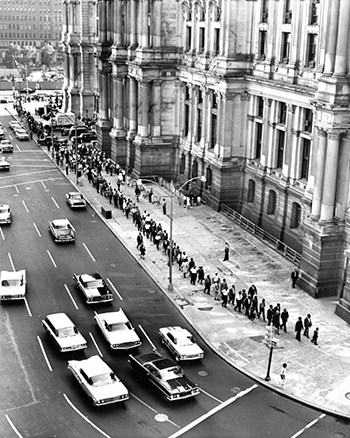
Collection of the Smithsonian National Museum of African American History and Culture, Gift of the family of Dr. Maurice Jackson and Laura Ginsburg Less than 24 hours after her husband died, Myrlie Evers asked to address a mass meeting that had been called at the Pearl Street African Methodist Episcopal Church in Jackson. Five hundred attendees listened, some openly wept. The New York Times reported her words.
Not only was Myrlie Evers an effective orator, but she also represented a powerful image for the civil rights movement. At her husband’s funeral her private grief went on public display. Funeral and ServicesMore than four thousand people attended Evers’s funeral at the Masonic Temple, including NAACP Executive Director Roy Wilkins, Dr. Martin Luther King Jr., James Meredith, and US Congressman Charles Diggs. Afterward, five thousand people marched almost two miles from the Masonic Temple to Collins Funeral Home where Evers’s body was prepared to be sent by train for burial at Arlington National Cemetery. Later, several hundred mourners, mostly students, marched toward the white business district and encountered the armed force of the Jackson police. Evers was buried with full military honors at Arlington National Cemetery on June 19, 1963. More than twenty-five thousand people viewed the procession and an estimated two thousand attended the graveside service, including Attorney General Robert F. Kennedy. Following the funeral, President John F. Kennedy invited Myrlie Evers and her children, along with Charles Evers, Medgar’s brother, to the White House. Coast to coast, national press focused attention on Evers’s murder. Mourners held vigils and memorial services around the country. Perhaps the largest of these occurred at the Metropolitan Community Church in Chicago’s Bronzeville community—Emmett Till’s neighborhood—where one thousand people attended a service in Evers’s honor and Martin Luther King, Jr., and his mentor Dr. T. R. M. Howard spoke of his martyrdom. 
Special Collections Research Center, Temple University Libraries, Philadelphia, PA, George D. McDowell Philadelphia Evening Bulletin Photographs The Stoic WidowArresting images of a mourning widow tending to tearful children, filled the cover and pages of Life magazine, a popular publication seen by more than half of the US adult population. The images brought home to readers the consequences of virulent racism taken to its violent conclusion. The widow and children of Medgar Evers, Myrlie Evers observed, “became a powerful public relations tool” for the NAACP, which had long used publicity as part of its fight for racial justice. The organization reprinted a photograph of her taken at the funeral, a tear running down her cheek, and posted it in train stations and bus terminals throughout the country. It also appeared on the cover of Myrlie’s 1967 memoir For Us, the Living. The images inspired even as they saddened, and they helped the NAACP recruit members and raise money to promote civil rights causes. Because she was in such demand as a speaker Myrlie Evers convinced the organization to put her back on its payroll. No longer a behind-the-scenes participant, Myrlie established a career and record of activism, while also engaging in civic affairs. She delivered countless speeches that invoked Medgar’s memory. She stayed committed to the NAACP at the local and national levels, joining the NAACP National Board of Directors. Her work with the NAACP culminated in her term from 1995 to 1998 as the board’s chair. Civil Rights Act of 1964President Kennedy sent his bill to Congress on June 19, as Medgar Evers was being laid to rest in Arlington. Kennedy signed a copy of the draft bill for Myrlie Evers when she visited the White House. A year of debate and legislative maneuvering awaited it. Kennedy’s own assassination in November 1963 moved it forward again. President Lyndon B. Johnson finally signed it into law on July 2, 1964. Considered a landmark in the civil rights movement, the Civil Rights Act of 1964 outlawed discrimination based on race, color, religion, sex, or national origin. It barred unequal voter registration requirements, whereby county clerks could give different tests to different voters; outlawed discrimination in public accommodations such as hotels, restaurants, and theaters; prohibited state and local governments from denying access to public facilities on the basis of race, color, religion, sex, or national origin; and authorized the U.S. Attorney General to file suits to enforce desegregation of public schools. The Act gave federal backing to many of the central tenets of the civil rights movement for which Evers had died fighting. Strengthened by the Voting Rights Act of 1965, thousands of new African American voters joined the South’s political system, with far-reaching and long-lasting results, as Evers and the NAACP had predicted. It also brought about a split in the Democratic Party, as old segregationists found themselves suddenly forced to appeal to these new voters or lose elections. |
Last updated: June 13, 2022
